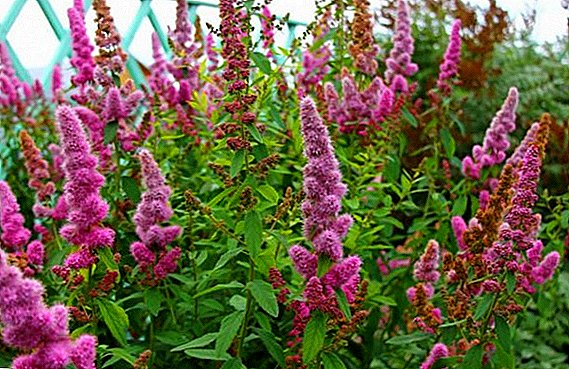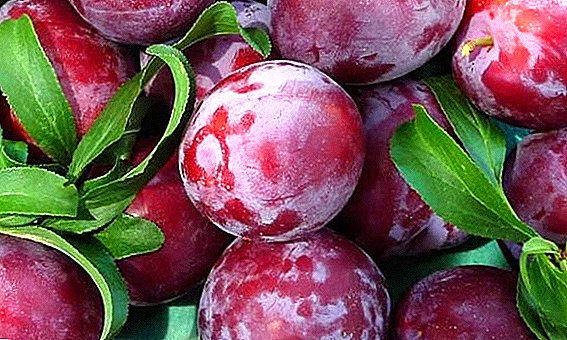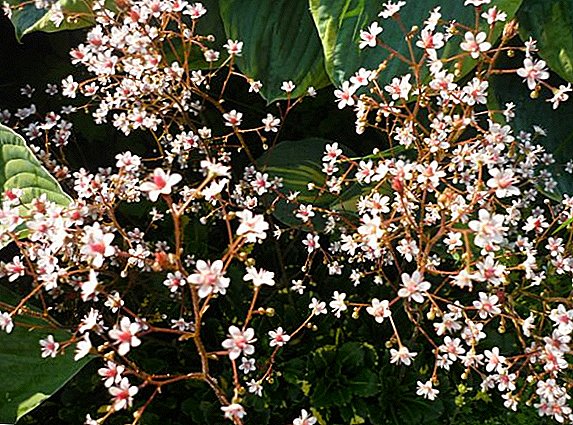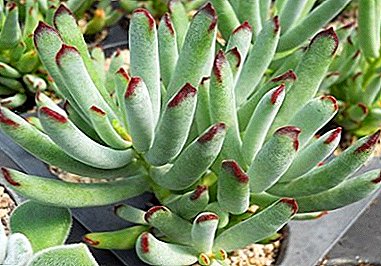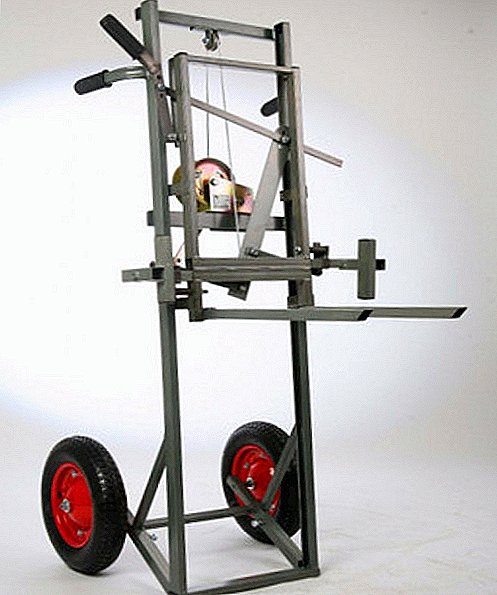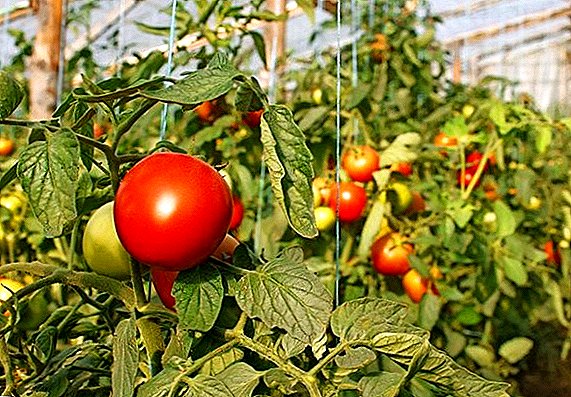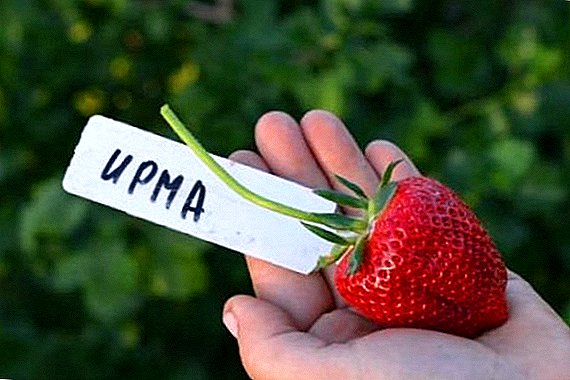 Each of us at least once in my life tried garden strawberries, popularly referred to as simply strawberries. And surely, in the depths of his soul, everyone would have dreamed of growing such a miracle berry in his garden. If you have at least a small garden plot, then you are quite capable of growing independently with minimal knowledge and skills to grow strawberries of the Irma variety - a sweet, juicy and unpretentious southern beauty.
Each of us at least once in my life tried garden strawberries, popularly referred to as simply strawberries. And surely, in the depths of his soul, everyone would have dreamed of growing such a miracle berry in his garden. If you have at least a small garden plot, then you are quite capable of growing independently with minimal knowledge and skills to grow strawberries of the Irma variety - a sweet, juicy and unpretentious southern beauty.
Variety description
Gardeners and gardeners appreciate Irma for tenderness and fragrance. It is difficult to find a more popular variety of strawberries, because the fruits grow large enough and produce a high yield, and care for it is minimal. 
The variety "Irma" is from Italy, where breeders in 1997 successfully bred a southern berry adapted to high mountain areas. In our latitudes, strawberries can ripen both in hot climates and in temperate continental, withstanding some humidity.
Strawberries of this variety are dessert.
Other strawberry varieties include the Queen Elizabeth, Roxana, Masha and Malvina.
The taste of the berries with a pronounced sweetness, but not cloying, but complex and multifaceted due to the barely perceptible sourness. As for the flavor, some varieties of garden strawberries smell much stronger than our heroine.
But this is not so important for farmers who choose the juicy, dense, but not sinewy Irma berries for breeding, because even in the rainy season they do not lose their taste and sugar content. For comparison, the popular classic "Albion" gives tougher and much less sweet berries.
Low calorie content translates this sweet berry into the category of dietary, and the ability to improve metabolism into the category of very healthy foods. Even diabetics are not harmful to periodically treat themselves with juicy strawberries, because it does not increase blood sugar levels. 
Characteristics of berries and yield
As for the fruits, then, as already mentioned, they are very large - one berry can weigh 25-30 g or even more. Dense, cone-shaped with a pointed nose, rich red.
Variety refers to the medium early, the highest yield is usually from the first harvest (June), then the berry is a little shallow and slightly inferior in juiciness (August-September). Bushes of medium size with high long stalks. Gardeners also note excellent learning.
Did you know? In the strawberry varieties "Irma" contains so much vitamin C, that a few large berries is enough to fill the daily rate of the body. It also contains antioxidants and many useful elements like iodine and zinc.
The highest peak of fruiting falls in the second year of planting, then the yield drops and disappears. Therefore, those who are seriously engaged in the commercial cultivation of strawberries, you must take care of the seedlings in advance and update the planting for the third year already. 
If you grow a berry for yourself at the dacha, then with good nourishment and moisture the bushes will be optimally fertile for up to four years.
The bush of the Irma is bearing fruit all summer, the harvest is going in three or four doses. Given its high yield (2 kg per bush with average care), resistance to frost and dry weather conditions, strawberries of this variety become ideal for sale.
Let's add here the transportability - the ability not to cluck during transportation and maintain the presentation.
Agrotechnics of growing and caring for strawberries
Grow strawberries with seedlings. Bushes are not too sprawling, so the landing is carried out quite tightly on the beds of meter width. 
Resistance to drought is manifested in the fact that the berry does not sinter even on the southern July midday and continues to grow. Having given only a minimal amount of time to shading and good irrigation, it is possible even in such conditions to achieve a frequent and abundant harvest.
Selection of seedlings
From February to early May prepare containers for seedlings. Fill them with soil (2 parts of sod land for one part of peat and sand) and plant seeds. Until they give the first shoots, the containers should be under the film.
Film regime is interrupted every day for half an hour - the plants need to breathe. Do not forget about the temperature regime - the optimum is +18 ° C, it can be a little higher, below - it is impossible. With the appearance of several leaves, saplings dive into separate containers. The seedling, where each sprout already has five leaves and more, is ready for transplanting in open ground, to a well-lit place.  The roots of the bushes must have a healthy look and be strong. In the shade, strawberries will also grow, but smaller.
The roots of the bushes must have a healthy look and be strong. In the shade, strawberries will also grow, but smaller.
Conditions of detention
The fact that the variety is light-requiring and resistant to dry weather, has already been mentioned earlier. But everything needs a balance, so if you planted strawberries under the scorching sun, then be prepared for regular and abundant watering.
In general, "Irma" is quite demanding of moisture, and if you organize a drip irrigation system on the plot, it will solve all the problems with strawberries.
Learn how to make drip irrigation from scrap materials, how to make drip irrigation from plastic bottles, how to choose and install drip tape, and how to water strawberries when planting, how often to water strawberries.
In the first year of planting, it is better to sacrifice flower stalks and cut them off so that all the juices go to strengthen the root system. Experienced farmers are always advised to organize part of the planting for fruiting, and part - for the queen plant. Thus, in the first case, the whiskers are broken, in the second, the flower stalks are completely broken. 
You can grow our strawberries not only in the open field, but also in greenhouses, and even in packets.
Soil and fertilizer
Irma will respond to good food with high yield and bright taste. When the first ovaries appear in early spring, each bush should be seasoned with a mineral-nitrogen fertilizer. Ash is an excellent fertilizer, it feeds strawberries and at the same time protects it from pests.
Mentally break the time from planting into the ground before fruiting into three parts and at this time be sure to loosen the ground, saturating it with oxygen. Also, we can not do without weeding and removing red leaves.
Worst of all, strawberry variety "Irma" takes root in sandy and clay soils. Also, you should not plant bushes in alkaline soil and a soil with high acidity. They do not have enough nutrients for growth, and rhizomes can rot from excess moisture. 
Humic soil is best suited, especially since you can create such a layer yourself by taking care of the rotted plant residues in advance from your garden.
Important! Peat soil is loved by many gardeners, but do not forget that it also has high acidity. It is absolutely necessary to add dolomite flour, limestone or sawdust to reduce this indicator.
Watering and moisture
Strawberry of this variety loves moisture and without proper watering in the summer heat can produce a small crop. Regular watering is recommended during the entire fruiting season. If you mulch bushes, the ground will hold moisture longer. 
Relation to temperature
If in your area winters are slushy and there is little snow, then it will not be superfluous to mulch strawberries before winter (by humus, peat, agrofiber). Before wintering, watering is stopped, and whiskers and leaves that have been damaged are removed.
Reproduction and planting
The reproduction of this variety does not cause any special difficulties, because the mustache grows great. But do not forget that the whiskers give bushes of one to two years of age, and for reproduction rooted the first few outlets.
Important! Already in the first year after planting, you should think about breeding, so leave some shrubs specifically for the production of whiskers.
Planting is carried out according to the standard scheme: the distance between plants should not exceed 30 cm, between rows - 40 cm. It is better to plant in spring, but it is possible at the end of summer. In the southern regions, sometimes they are planted with landing until October, but later it is impossible, otherwise the yield drops. 
The ideal option would be the preparation of planting soil in advance. For example, first plant a place for the alleged planting of strawberries with rape or clover. These plants will enrich the soil with nitrogen, and the berry planted behind them will feel much better.
Before planting, the land must be loosened and weeds weeded. Organic fertilizers are placed in each hole.
As an organic fertilizer, use is made of straw, bone and fish meal, milk whey, egg shells, onion peel, nettle.
You can make them yourself, for example, take 10 kg of compost per 10 kg of chernozem, add some biohumus (about 2 liters) and 0.5 kg of ash. Roots are guided vertically, the optimal well size is 25 cm in length, width and depth.
After planting, each bush is abundantly watered and mulched with wood or coniferous sawdust.
Possible difficulties in growing
In addition to the organization of watering, as well as the correct distribution of bushes for vegetative reproduction (antennae), there should not be any special difficulties with Irma. Regular loosening and timely feeding, mulching are the factors that are needed to get a crop from any crop. 
As a preventive measure for diseases of the remontant strawberry, to which our variety belongs (that is, it gives a crop in waves, several times per season), it is important to select sustainable sprouts for planting right away.
Pests, diseases and prevention
This variety is highly resistant to fungal diseases and rot, but alternaria can be a problem. This disease is triggered by a mold fungus, the leaves of the plant are covered with brown or black spots, and the pollen becomes dangerous for asthmatics.
The following measures will be taken to prevent the disease:
- autumn soil loosening (at least half a meter deep);
- spraying with fungicides at the first signs of plant damage;
- regular and thorough inspection of the fruit and removal of the affected fungus.

Ash fertilizer will be an excellent prevention against pests.
Did you know? From uninvited feathered guests who want to enjoy your harvest, there is an amusing way to dare - to arrange red glass balls in the beds. Having unsuccessfully pecked the glass, the birds do not dare touch the ripe berries.
Do not forget that grapes, sea buckthorn, apple, iris or nasturtium will be good neighbors for our strawberries. And if legumes, garlic or onions were growing in front of the strawberries, then the conditions are just perfect.
Growing strawberries is a creative process. If you successfully select a variety that you can do, then you can achieve significant results and even think about the commercialization of your work. 
"Irma" in this regard is one of the most acceptable options, because you can start growing it at any time, and the yield and exquisite taste will be an excellent reward even for an inexperienced gardener.



